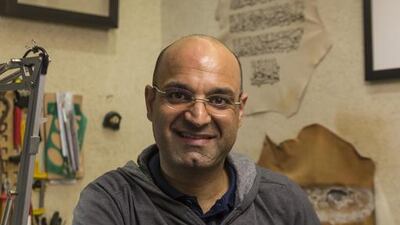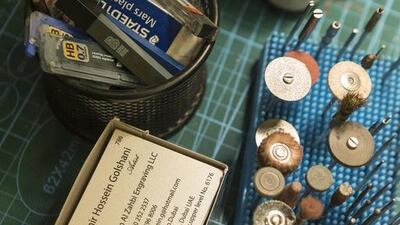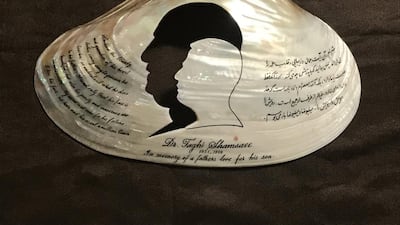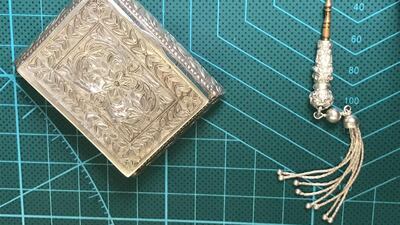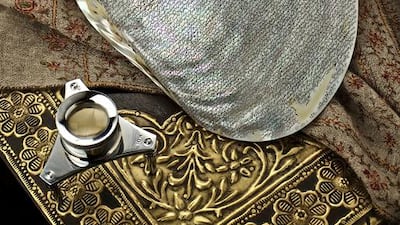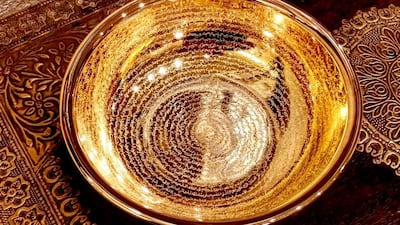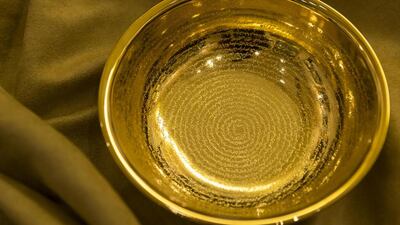Iranian calligrapher Amir Hossein wanted to create a unique gift for Sheikh Mohammed bin Rashid, Vice President and Ruler of Dubai, to thank him for the artistic freedom and happiness he has experienced since moving to Dubai 10 years ago.
“My teacher used to say that ‘through art, you can make anything possible’. Finally, I came up with something nobody else in the world would have, and nobody could copy. This masterpiece is the smallest, most confidential stamp in the world, and is the most difficult piece of art I have ever made.”
The 0.9mm brass and silver stamp, which bears the name Mohammed bin Rashid in Arabic, can only be seen using a magnifying glass. And yet, incredibly, Hossein did not use a magnifier for this micro-engineering feat. In fact, he did not use his sight at all, instead relied purely on his sense of touch to engrave the surface, which is smaller than a pin.
Because it is a stamp, Hossein had to engrave the writing in reverse, deep onto the surface. “To carve something so small, I have to get into a meditative state. I brought my heart’s pulse to about 50, then I stopped breathing. As I engraved, I transferred myself into what I was doing,” he admits.
The final stamp was Hossein’s 161st attempt, after spending five hours a day for six months on the project. And while most would find that frustrating, he did not.
“Every time I tried again, I felt I had more power to do it. All of my life’s experience and talent is inside this art piece. I need daily challenges like this to always be creative.”
The stamp does not require ink to work, just a little pressure, and could come in handy as a means to authenticate royal documents. Although Hossein believes his stamp is the world’s smallest, Guinness World Records refused to reward him with that title. They sent him a letter that read: “With such categories, it reaches a point where the item cannot possibly get any smaller, which means at some point someone will hold a record which can never be broken again … we believe that a record should always be breakable.”
If you visit Hossein’s studio at Wafi Mall’s Khan Murjan Souq in the mornings, you are likely to see a queue of Japanese people snaking out the door.
“Even though I do not speak Japanese, we have very heartfelt conversations and I learn many things from them,” he says.
Clients often ask him to engrave personal messages, Quranic verses or the names of loved ones onto an array of materials – from gold and platinum metals to leather, bamboo, deer horns and emu eggs.
Hossein has written calligraphy in Japanese, Russian, Farsi and English, and often shapes the words to make animal forms, such as an elephant or a fish.
In an era when machines in factories can mass-produce almost anything, traditional craftsmen such as Hossein are a rare breed. But he believes his pieces provide something which machines will never be able to. “I put a part of my soul inside my pieces – they stay with the owner forever. This is not my business, this is my love. I give people something, but I receive a lot more back.”
Hossein’s studio is full of tools to suit the job at hand. To cut the coffee urn from a one dirham coin, as he did for a recent jewellery piece “for a princess who lives in Vienna”, he used a saw with a hair-like blade, which he says is “very thin, but very sharp”.
For micro-engraving the Arabic word for Allah onto the top of a 0.2mm steel needle, a particularly strong tool is required. “Finally, I found carbide. I cut the carbide shape for the tool with a diamond disc.”
Last month, Hossein was asked by an Iranian-American man to come up with “something incredible” as a gift for his brother’s 50th birthday. To help him create something with a personal resonance, the man gave Hossein a bunch of family photographs, and a copy of a letter his father wrote to his sons shortly before he died.
“When I read this letter, about the love this man felt for them, it really touched me to make something special,” admits Hossein.
The resulting piece is a shell onto which Hossein carved the outlines of the faces of the father and his son, along with heartfelt inscriptions in Farsi and English.
“This represents how his father’s shadow is always with him,” he explains. “You can see the orbits, the natural lines in the shell, which represent how the father’s energy lives on.”
Hossein had a near-death experience recently, which he says was a “revolution in his life”.
“It made me see how we are all really living in a dream. When we pass away, we wake up. After coming back from death, I chose an easier life, because I could see how everything is meant to be. We should enjoy our lives, and just focus on making good memories for people.”
Hossein’s love of calligraphy was developed as a child in the early 1980s during the Iran-Iraq war. Learning conditions at his school were “very bad”, with 40 children huddled in a classroom smaller than Hossein’s studio.
All the usual teachers were away fighting, and the man brought in to teach the class was a retired master of calligraphy.
“I was very lazy and a bad writer,” he says. “But this teacher took my hand and showed me how to write. He changed my life forever because he enabled me to believe in myself. I would like to give that same lesson to the next generation.”
One of Hossein’s finest achievements is a 24-carat gold bowl, hand-engraved with 20 pages of the Quran, designed to drink water from to boost health. It took two months to make and was completed earlier this year.
Unlike the other ornaments and pictures which are on display in his studio, Hossein keeps this treasured item hidden from view. “It is very difficult for me to imagine selling this bowl, because it is like my baby,” he admits.
“I’d only sell it for Dh200,000, and I’d use the proceeds to set up a ‘talent school’ to help the children of today realise their potential.”
He recalls the words of his teacher, which he says have been passed down through generations of calligraphers since the time of Prophet Mohammed: “Good handwriting for rich people is beauty. For poor people, it means money. For men of knowledge, it is perfection. Whatever category you’re in, you will receive benefit from handwriting, so try to be a good writer. I am in the poor bracket. If I become rich, that is beautiful. But if I become wise, that for me is perfection.”
• Watch Hossein at work on video at www.thenational.ae and check out more of his work at www.instagram.com/goldenpen.dubai
artslife@thenational.ae
